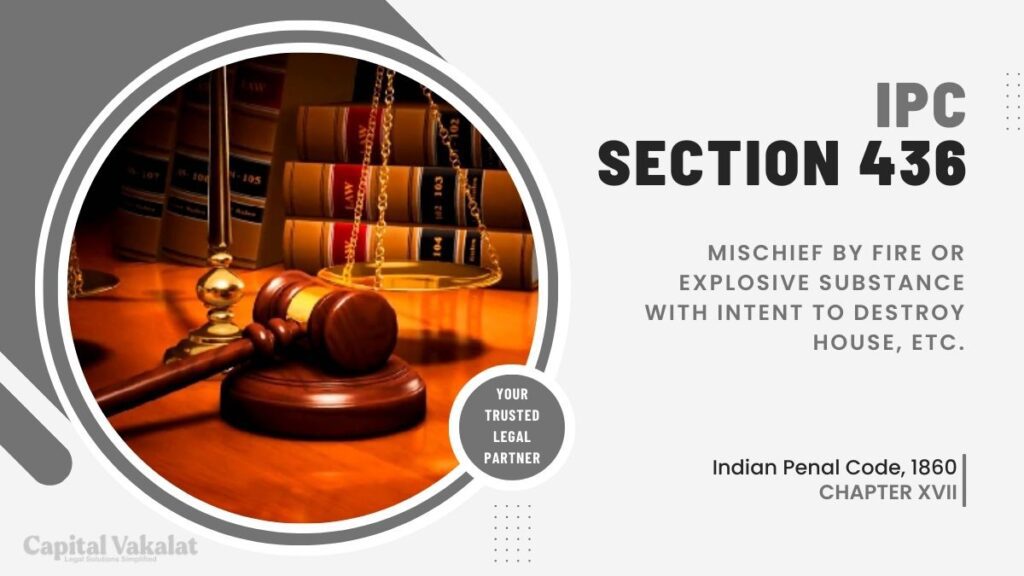Fire has been both a friend and a foe throughout human history. While it has been instrumental in our progress, it can also become a destructive force when used with malicious intent. In legal terms, Section 436 of the Indian Penal Code (IPC) deals specifically with mischief by fire or explosive substance with the intent to destroy property, especially houses.

Let’s delve into the intricacies of this section and understand its implications.
Understanding Section 436 IPC
Section 436 IPC is a crucial provision that addresses acts involving the use of fire or explosive substances to cause mischief. The section is designed to curb and penalize activities that jeopardize the safety and security of properties, particularly residences. To comprehend its significance, it’s essential to break down the elements of this legal provision.
Elements of Mischief by Fire or Explosive Substance
The first aspect to consider is the nature of the act itself. Section 436 requires that the accused engage in mischief, which involves intentionally causing damage or destruction. In this context, mischief is carried out using fire or explosive substances, amplifying the potential harm and danger associated with such actions.
Intent to Destroy Property
Crucial to the application of Section 436 is the element of intent. The perpetrator must have a deliberate and conscious intention to destroy the property, especially houses. This requirement emphasizes the gravity of the offense, as it distinguishes between accidental incidents and those driven by malicious motives.
Consequences and Punishments
The legal consequences for violating Section 436 are severe, reflecting the societal importance of safeguarding property. Offenders may face imprisonment, fines, or a combination of both. The severity of the punishment depends on factors such as the extent of damage caused and the specific circumstances surrounding the act.
Legal Defenses
While the law is stringent, there are legal defenses available to those accused under Section 436. These defenses may include establishing an alibi, proving lack of intent, or challenging the evidence presented. Understanding these defenses is crucial for individuals accused under this section to ensure a fair trial.
Landmark Cases
Examining past cases can provide valuable insights into the interpretation and application of Section 436. Landmark cases serve as precedents, shaping how the legal system handles instances of mischief by fire or explosive substances. Analyzing these cases helps in understanding the evolving dynamics of such legal matters.
Impact on Society
The widespread prevalence of incidents covered under Section 436 has a profound impact on society. Beyond the immediate victims, entire communities can be affected, leading to a sense of insecurity and fear. Exploring the broader repercussions of such acts sheds light on the societal dimensions of this legal provision.
Importance of Legal Awareness
Enhancing legal awareness is pivotal in preventing offenses under Section 436. Communities and individuals need to be educated about the legal consequences of engaging in malicious acts involving fire or explosive substances. This awareness not only acts as a deterrent but also fosters a sense of responsibility within society.
Conclusion
In conclusion, Section 436 IPC plays a crucial role in safeguarding properties and maintaining societal order. Its emphasis on intent and the use of destructive elements underscores the seriousness with which the legal system views such actions. Legal awareness, combined with stringent enforcement, is essential to mitigate the occurrences of mischief by fire or explosive substances.
Frequently Asked Questions
Can accidental fires be prosecuted under Section 436?
No, Section 436 specifically requires the element of intent, distinguishing between accidental incidents and those driven by malicious motives.
Are there any legal defenses for those accused under Section 436?
Yes, legal defenses such as establishing an alibi or proving lack of intent can be used to contest charges under Section 436.
How do landmark cases influence the application of Section 436?
Landmark cases serve as precedents, shaping the interpretation and application of Section 436 in subsequent legal proceedings.
What role does legal awareness play in preventing offenses under Section 436?
Legal awareness is crucial in preventing offenses by educating communities and individuals about the legal consequences associated with mischief by fire or explosive substances.